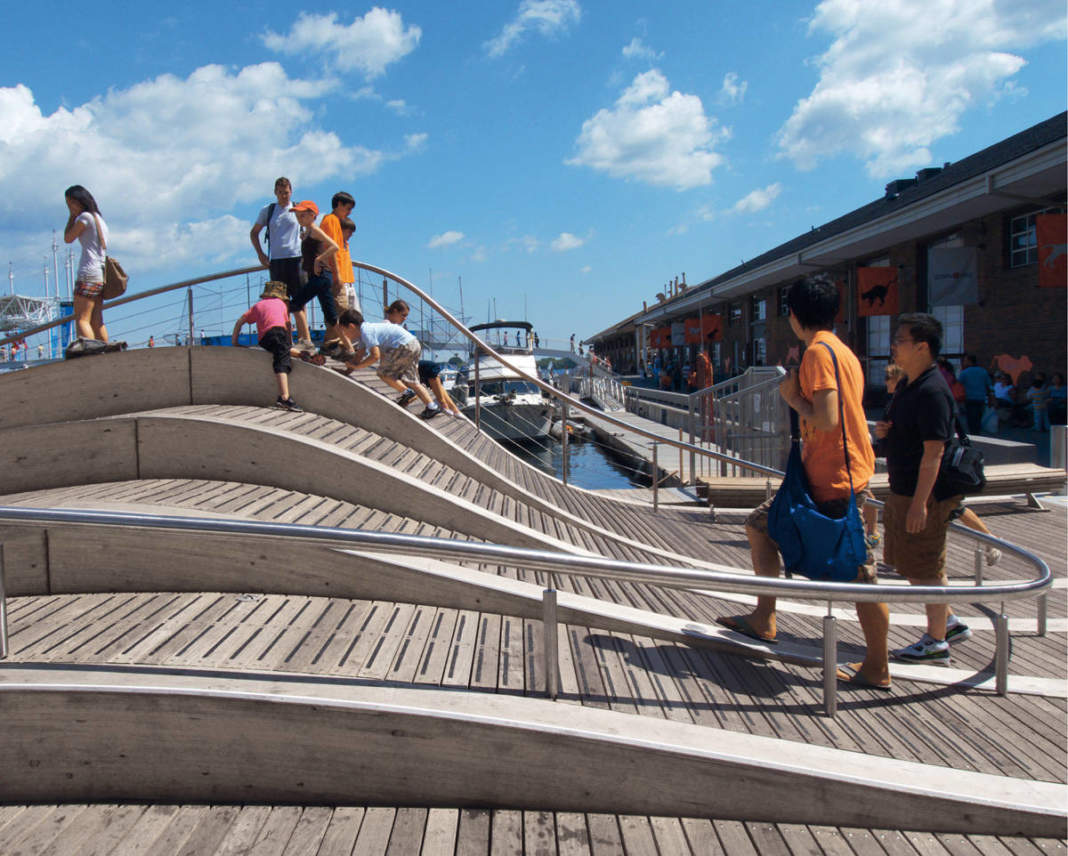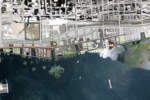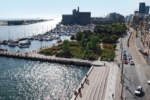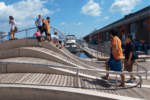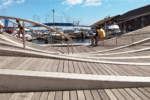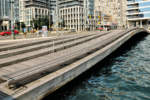architect: West 8
location: Toronto, Canada
year: 2008
Five steps to the lake. Spadina WaveDeck is the first in a series of timber structures that explore variations of a simple articulation in the change in level between Queens Quay Boulevard and Lake Ontario along the Toronto Central Waterfront. Responding to the current pinch-points where the streetscape meets the water’s edge, a new public space gateway is created where the city kisses the lake, inspired by the sinuous contours of the shoreline of the Canadian lakefront. The geometry of the WaveDeck is carefully conceived using playful curves that are constantly changing to create ledges for seating and new routes to access the water’s edge. It allows for different vantage points and ultimately different experiences with both the lake and the city. In order to establish a coherent aesthetic for the public realm along the waterfront, the simple undulating timber wave gesture became a prototype that will be repeated at seven heads of slips with subtle variation. Using a consistent palette of materials and details, the identity of each wave structure will be derived from the unique curvatures of the structure as well as the activities suggested through its form. Different levels of contact with the lake and a curving 57 m bench along the edge highlight the experience at Spadina. The WaveDeck also includes the creation of new fish habitat below the cantilevered structure. Riverstone shoals, tree logs and embankments were installed to provide shelter and increased feeding and forging opportunities for lake fish. In-water LED lights have been installed to create a surreal experience by night.
West 8 is an award-winning international office for urban design and landscape architecture, founded by Adriaan Geuze in 1987. Over the last 20 years West 8 has established itself as a leading practice with an international team of 70 architects, urban designers, landscape architects and industrial engineers. West 8’s main office is based at the port of Rotterdam, and has three branch offices in Belgium, New York and Toronto. West 8’s New York office was established after winning an international design competition for the design of Governors Island Park – a 172-acre island in the New York Harbor. West 8’s Toronto office primarily serves the local Waterfront Project. West 8 approaches the production of nature in two different – but characteristically Dutch – ways. First, we take a classic civil engineering approach for creating landscape - a logic based on utility and necessity. Second, we are part of a landscape tradition that confers identity and, therefore, understand the need for creating symbols in the production of landscape. This method envisions a new nature, a ’second nature’ of constructed landscapes that respond to pragmatic demands (water management, population growth, traffic congestion) and also reinforce the culture to which they belong (identity, symbols, expression). In a departure from the old demolish and install engineering methodology, or the current preserve and protect model, we are adding and expressing new natures. The real future in today’s debate about sustainability lies not in a political or philosophical dialogue about what we are protecting or how we are going to sustain” it, but rather how to actively create new ecologies. Creating land and then painting it: in many ways, this is the soul of Dutch culture.


